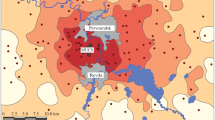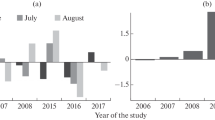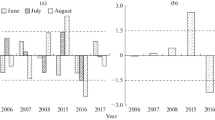Abstract
Analysis of natural recovery of communities after reduction of industrial emissions is important for gaining an insight into their stability. However, there is obvious deficit in observations on the course of this recovery; in particular, no data on direct comparisons of the state of communities before and after reduction of emissions are available for soil macroinvertebrates. We have studied the structure of soil macrofauna communities at the level of supraspecific taxa in southern taiga spruce-fir forests in the region exposed to emissions from the Middle Ural Copper Smelter (MUCS; Revda, Sverdlovsk oblast). The data over three periods—high, reduced, and almost terminated emissions (1990–1991, 2004, and 2014–2016, respectively)—have been compared to test the hypothesis that the communities do not recover rapidly. The results partly confirm this hypothesis. On the one hand, the response of pedobionts to pollution at a qualitative level has remained basically unchanged: in each of the three periods, their total abundance (and that of the majority of groups) decreased abruptly as the MUCS was approached, with dominance shifting from saprophages to phyto- and zoophages. On the other hand, signs of recovery have appeared during the last period: the abundance of pedobionts has increased, and pollution-sensitive groups (earthworms, enchytraeids, and mollusks) have approached closer to the MUCS. This is most likely explained by decrease in the toxicity of metals due to normalization of soil pH. Rapid recolonization of defaunated territory may be accounted for by the presence in it of microsites with more favorable conditions, compared to the surrounding area, which allow low-mobile forms to survive beyond the boundaries of their main distribution area.
Similar content being viewed by others
References
Brussaard, L., Pulleman, M.M., Ouedraogo, E., et al., Soil fauna and soil function in the fabric of the food web, Pedobiologia, 2007, vol. 50, no. 6, pp. 447–462.
Paoletti, M.G. and Bressan, M., Soil invertebrates as bioindicators of human disturbance, Crit. Rev. Plant Sci, 1996, vol. 15, no. 1, pp. 21–62.
De Vauflery, A. Poinsot-Balaguer, N., et al., The use of invertebrate soil fauna in monitoring pollutant effects, Eur. J. Soil Biol., 1999, vol. 35, no. 3, pp. 115–134.
Rusek, J. and Marshall, V.G., Impacts of airborne pollutants on soil fauna, Annu. Rev. Ecol. Syst., 2000, vol. 31, no. 1, pp. 395–423.
Bengtsson, G. and Tranvik, L., Critical metal concentrations for forest soil invertebrates: A review of the limitations, Water Air Soil Pollut., 1989, vol. 47, nos. 3–4, pp. 381–417.
Stepanov, A.M., Chernen’kova, T.M., Vereshchagina, T.N., and Bezukladova, Yu.O., Assessment of the impact of technogenic emissions on soil invertebrates and vegetation, Zh. Obshch. Biol., 1991, vol. 52, no. 5, pp. 699–707.
Nekrasova, L.S., Impact of copper smelting on soil macrofauna, Ekologiya, 1993, no. 5, pp. 83–85.
Nahmani, J. and Lavelle, P., Effects of heavy metal pollution on soil macrofauna in a grassland of Northern France, Eur. J. Soil Biol., 2002, vol. 38, nos. 3–4, pp. 297–300.
Gongalsky, K.B., Filimonova, Z.V., Pokarzhevskii, A.D., and Butovskii, R.O., Differences in responses of herpetobionts and geobionts to impact from the Kosogorsky Metallurgical Plant (Tula region, Russia), Russ. J. Ecol., 2007, vol. 38, no. 1, pp. 52–57.
Tanasevich, A.V., Rybalov, L.B., and Kamaev, I.O., Dynamics of soil macrofauna in the zone of technogenic impact, Lesovedenie, 2009, no. 6, pp. 63–72.
Vorobeichik, E.L., Ermakov, A.I., Zolotarev, M.P., and Tuneva, T.K., Changes in the diversity of soil macrofauna along an industrial pollution gradient, Russ. Entomol. J., 2012, vol. 21, no. 2, pp. 203–218.
Korkina, I.N. and Vorobeichik, E.L., The humus index: A promising tool for environmental monitoring, Russ. J. Ecol., 2016, vol. 47, no. 6, pp. 526–531.
Korkina, I.N. and Vorobeichik, E.L., Humus index as an indicator of the topsoil response to the impacts of industrial pollution, Appl. Soil. Ecol., 2018, vol. 123, pp. 455–463.
Vorobeichik, E.L. and Nesterkova, D.V., Technogenic boundary of the mole distribution in the region of copper smelter impacts: Shift after reduction of emissions, Russ. J. Ecol., 2015, vol. 46, no. 4, pp. 377–380.
Sukhareva, T.A. and Lukina, N.V., Mineral composition of assimilative organs of conifers after reduction of atmospheric pollution in the Kola Peninsula, Russ. J. Ecol., 2014, vol. 45, no. 2, pp. 95–102.
Belskii, E. and Grebennikov, M., Snail consumption and breeding performance of pied flycatchers (Ficedula hypoleuca) along a pollution gradient in the Middle Urals, Russia, Sci. Tot. Environ., 2014, vol. 490, pp. 114–120.
Pacyna, J.M., Pacyna, E.G., and Aas, W., Changes of emissions and atmospheric deposition of mercury, lead, and cadmium, Atmos. Environ., 2009, vol. 43, no. 1, pp. 117–127.
Babin-Fenske, J. and Anand, M., Terrestrial insect communities and the restoration of an industrially perturbed landscape: Assessing success and surrogacy, Restor. Ecol., 2010, vol. 18, Suppl. 1, pp. 73–84.
Babin-Fenske, J. and Anand, M., Patterns of insect communities along a stress gradient following decommissioning of a Cu-Ni smelter, Environ. Pollut., 2011, vol. 159, no. 10, pp. 3036–3043.
Nahmani, J. and Rossi, J.-P., Soil macroinvertebrates as indicators of pollution by heavy metals, C. R. Biol., 2003, vol. 326, no. 3, pp. 295–303.
Niemeyer, J.C., Nogueira, M.A., Carvalho, G.M., et al., Functional and structural parameters to assess the ecological status of a metal contaminated area in the tropics, Ecotoxicol. Environ. Saf., 2012, vol. 86, pp. 188–197.
Ma, W.-C. and Eijsackers, H., The influence of substrate toxicity on soil macrofauna return in reclaimed land, in Animals in Primary Succession. The Role of Fauna in Land Reclamation, Cambridge, 1989, pp. 223–244.
Curry, J.P. and Good, J.A., Soil faunal degradation and restoration, in Soil Restoration, Lal, R. and Stewart, B.A., Eds., New York, 1992, pp. 171–215.
Dunger, W., Wanner, M., Hauser, H., et al., Development of soil fauna at mine sites during 46 years after afforestation, Pedobiologia, 2001, vol. 45, no. 3, pp. 243–271.
Cristescu, R.H., Frere, C., and Banks, P.B., A review of fauna in mine rehabilitation in Australia: Current state and future directions, Biol. Conserv., 2012, vol. 149, no. 1, pp. 60–72.
Vorobeichik, E.L. and Kaigorodova, S.Yu., Long-term dynamics of heavy metals in the upper horizons of soils in the region of a copper smelter impacts during the period of reduced emission, Euras. Soil Sci., 2017, vol. 50, no. 8, pp. 977–990.
Vorobeichik, E.L., Sadykov, O.F., and Farafontov, M.G., Ekologicheskoe normirovanie tekhnogennykh zagryaznenii nazemnykh ekosistem (lokal’nyi uroven’) (Ecological Rating of Technogenic Pollutants in Terrestrial Ecosystems: Local Level), Yekaterinburg: Nauka, 1994.
Vorobeichik, E.L., Response of the soil biota to emissions from copper smelters in forest ecosystems of the Middle Urals, Extended Abstract of Cand. Sci. (Biol.) Dissertation, Yekaterinburg, 1995.
Vorobeichik, E.L., Populations of earthworms (Lumbricidae) in forests of the Middle Urals in conditions of pollution by discharge from copper works, Russ. J. Ecol., 1998, vol. 29, no. 2, pp. 85–91.
Vorobeichik, E.L., Trubina, M.R., Khantemirova, E.V., and Bergman, I.E., Long-term dynamic of forest vegetation after reduction of copper smelter emissions, Russ. J. Ecol., 2014, vol. 45, no. 6, pp. 498–507.
Kaigorodova S.Yu. and Vorobeichik E.L., Changes in certain properties of grey forest soil polluted with emissions from a copper-smelting plant, Russ. J. Ecol., 1996, vol. 27, no. 3, pp. 177–183.
Vorobeichik, E.L., Seasonal changes in the spatial distribution of cellulolytic activity of soil microflora under conditions of atmospheric pollution, Russ. J. Ecol, 2007, vol. 38, no. 6, pp. 177–183.
Mikryukov, V.S., Dulya, O.V., and Vorobeichik, E.L., Diversity and spatial structure of soil fungi and arbuscular mycorrhizal fungi in forest litter contaminated with copper smelter emissions, Water Air Soil Pollut., 2015, vol. 226, no. 4, pp. 1–14.
Smorkalov, I.A. and Vorobeichik, E.L., The mechanism of stability of CO2 emission from the forest litter under industrial pollution, Lesovedenie, 2016, no. 1, pp. 34–43.
Kuznetsova, N.A. Soil-dwelling Collembola in coniferous forests along the gradient of pollution with emissions from the Middle Ural Copper Smelter, Russ. J. Ecol., 2009, vol. 40, no. 6, pp. 415–423.
Ermakov, A.I., Structural changes in the Carabid fauna of forest ecosystems under a toxic impact, Russ. J. Ecol., 2004, vol. 35, no. 6, pp. 403–408.
Belskaya, E.A. and Zinov’ev, E.V., The structure of ground beetle assemblages (Coleoptera, Carabidae) in natural and technogenic forest ecosystems in the southwest of Sverdlovsk oblast, Sib. Ekol. Zh., 2007, no. 4, pp. 533–543.
Zolotarev, M.P. and Nesterkov, A.V., Arachnids (Aranei, Opiliones) in meadows: Response to pollution with emissions from the Middle Ural Copper Smelter, Russ. J. Ecol., 2015, vol. 46, no. 1, pp. 81–88.
Ermakov, A.I., Changes in the assemblage of necrophilous invertebrates under the effect of pollution with emissions from the Middle Ural Copper Smelter, Russ. J. Ecol., 2013, vol. 44, no. 6, pp. 515–522.
Belskaya, E.A. and Vorobeichik, E.L., Responses of leaf-eating insects feeding on aspen to emissions from the Middle Ural Copper Smelter, Russ. J. Ecol., 2013, vol. 44, no. 2, pp. 108–117.
Mukhacheva, S.V., Long-term dynamics of heavy metal concentrations in the food and liver of bank voles (Myodes glareolus) in the period of reduction of emissions from a copper smelter, Russ. J. Ecol., 2017, vol. 48, no. 6, pp. 559–568.
Belskaya, E.A., Dynamics of trophic activity of leaf-eating insects on birch during reduction of emissions from the Middle Ural Copper Smelter, Russ. J. Ecol., 2018, vol. 49, no. 1, pp. 87–92.
Mikhailova, I.N., Initial stages of recovery of epiphytic lichen communities after reduction of emissions from a copper smelter, Russ. J. Ecol., 2017, vol. 48, no. 4, pp. 335–339.
Tyler, G., Leaching rates of heavy metal ions in forest soil, Water Air Soil Pollut., 1978, vol. 9, no. 2, pp. 137–148.
Vorobeichik, E.L. and Pishchulin, P.G., Industrial pollution reduces the effect of trees on forming the patterns of heavy metal concentration fields in forest litter, Russ. J. Ecol., 2016, vol. 47, no. 5, pp. 431–441.
Lajeunesse, M.J., Bias and correction for the log response ratio in ecological meta-analysis, Ecology, 2015, vol. 96, no. 8, pp. 2056–2063.
Elpat’evskii, P.V. and Filatova, L.D., Soil macrofauna under anomalous ecological and geochemical conditions, Geogr. Prir. Resur., 1988, no. 1, pp. 92–97.
Haimi, J. and Matasniemi, L., Soil decomposer animal community in heavy-metal contaminated coniferous forest with and without liming, Eur. J. Soil Biol., 2002, vol. 38, no. 2, pp. 131–136.
De Vries, W., Romkens, P.F.A.M., and Schutze, G., Critical soil concentrations of cadmium, lead, and mercury in view of health effects on humans and animals, Rev. Environ. Contam. Toxicol., 2007, vol. 191, pp. 91–130.
Sivakumar, S., Effects of metals on earthworm life cycles: A review, Environ. Monit. Assess., 2015, vol. 187, no. 8, pp. 1–16.
McBride, M., Sauve, S., and Hendershot, W., Solubility control of Cu, Zn, Cd and Pb in contaminated soils, Eur. J. Soil Sci., 1997, vol. 48, no. 2, pp. 337–346.
Dube, A., Zbytniewski, R., Kowalkowski, T., et al., Adsorption and migration of heavy metals in soil, Pol. J. Environ. Stud., 2001, vol. 10, no. 1, pp. 1–10.
Vorobeichik, E.L. and Pozolotina, V.N., Microscale spatial variation in forest litter phytotoxicity, Russ. J. Ecol., 2003, vol. 34, no. 6, pp. 381–388.
Grumiaux, F., Demuynck, S., Pernin, C., and Lepretre, A., Earthworm populations of highly metal-contaminated soils restored by fly ash-aided phytostabilization, Ecotoxicol. Environ. Saf., 2015, vol. 113, pp. 183–190.
Kapusta, P. and Sobczyk, L., Effects of heavy metal pollution from mining and smelting on enchytraeid communities under different land management and soil conditions, Sci. Tot. Environ., 2015, vol. 536, pp. 517–526.
Schellhorn, N.A., Bianchi, F., and Hsu, C.L., Movement of entomophagous arthropods in agricultural landscapes: Links to pest suppression, Annu. Rev. Entomol., 2014, vol. 59, pp. 559–581.
Wellings, P.W., How variable are rates of colonization?, Eur. J. Entomol., 1994, vol. 91, no. 1, pp. 121–125.
Eijsackers, H., Earthworms as colonizers: Primary colonization of contaminated land, and sediment and soil waste deposits, Sci. Tot. Environ., 2010, vol. 408, no. 8, pp. 1759–1769.
Eijsackers, H., Earthworms as colonizers of natural and cultivated soil environments, Appl. Soil. Ecol., 2011, vol. 50, no. 1, pp. 1–13.
Cameron, E.K. and Bayne, E.M., Spatial patterns and spread of exotic earthworms at local scales, Can. J. Zool., 2015, vol. 93, no. 9, pp. 721–726.
Kramarenko, S.S., Active and passive migration of terrestrial mollusks: A review, Ruthenica, 2014, vol. 24, no. 1, pp. 1–14.
Ozgo, M. and Bogucki, Z., Colonization, stability, and adaptation in a transplant experiment of the polymorphic land snail Cepaea nemoralis (Gastropoda: Pulmonata) at the edge of its geographical range, Biol. J. Linn. Soc., 2011, vol. 104, no. 2, pp. 462–470.
Gongalsky, K.B., Belorustseva, S.A., Kuznetsova, D.M., et al., Spatial avoidance of patches of polluted chernozem soils by soil invertebrates, Insect Sci., 2009, vol. 16, no. 1, pp. 99–105.
Gongalsky, K.B., Filimonova, Zh.B., and Zaitsev, A.S., Relationship between soil invertebrate abundance and soil heavy metal contents in the environs of the Kosogorsky Metallurgical Plant, Tula oblast, Russ. J. Ecol., 2010, vol. 41, no. 1, pp. 67–70.
Lukkari, T. and Haimi, J., Avoidance of Cu- and Zn-contaminated soil by three ecologically different earthworm species, Ecotoxicol. Environ. Saf., 2005, vol. 62, no. 1, pp. 35–41.
Vorobeichik, E.L., Ermakov, A.I., Nesterkova, D.V., and Grebennikov, M.E., Coarse woody debris as a microhabitat for soil macrofauna in polluted areas, Dokl. Biol. Sci., 2019 (in press).
Artem’ev, A.V., Populyatsionnaya ekologiya mukholovkipestrushki v severnoi zone areala (Population Ecology of the Pied Flycatcher in the Northern Part of Its Range), Moscow: Nauka, 2008.
Author information
Authors and Affiliations
Corresponding author
Rights and permissions
About this article
Cite this article
Vorobeichik, E.L., Ermakov, A.I. & Grebennikov, M.E. Initial Stages of Recovery of Soil Macrofauna Communities after Reduction of Emissions from a Copper Smelter. Russ J Ecol 50, 146–160 (2019). https://doi.org/10.1134/S1067413619020115
Received:
Revised:
Accepted:
Published:
Issue Date:
DOI: https://doi.org/10.1134/S1067413619020115




